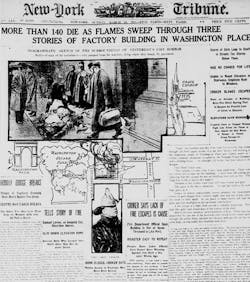Triangle Shirtwaist Factory: Lessons Still To Be Learned
More than 100 years after the fire that altered the course of worker safety in the United States, workers in other parts of the world still wait for justice.
On Saturday, March 25, 1911, a fire broke out on the top floors of the Triangle Shirtwaist factory in New York City. The workers, mostly women and young girls, were trapped inside because the factory owners had locked the exit doors to prevent them from leaving to go to the bathroom during their 12-hour shifts (there was no bathroom in the building).
When firefighters arrived, their ladders weren’t tall enough to reach the upper floors of the 10-story building, and many of the women began to jump to their deaths. Of the 500 people in the building, including managers, 146 workers perished.
But as Peter Dreier, E.P. Clapp Distinguished Professor of Politics, Occidental College, points out in a blog post on Huffington Post, “Ironically, more than a century after the Triangle fire, we still hear much of the same rhetoric whenever reformers seek to use government to [compel] businesses [to] act more responsibly and protect consumers, workers and the environment. For example, the disasters that killed 29 miners at Upper Big Branch and 11 oil rig workers in the Gulf several years ago could have been avoided had lawmakers resisted lobbying by mine owners and BP to weaken safety regulations.”
Dreier goes on to say, “Walmart could possibly have prevented the disastrous deaths of over a thousand garment workers in last year's collapse of the Rana Plaza factory building in Savar, Bangladesh, if had been willing to insist that its subcontractors meet basic safety standards.”
April 24, 2014, marks the one-year anniversary of the Rana Plaza collapse, in which more than 1,100 people – mostly garment workers – were killed and more than 2,500 were injured when the eight-story building collapsed. Worker advocates immediately began calling on the companies that contracted with the Rana Plaza garment factories – Walmat, the Gap, VF Corp. (owner of Nautica, Wrangler, Timblerland, Jansport and other brands), JC Penney and others – to demand better working conditions for these contract workers.
Unfortunately, in my opinion, the problems in the global supply chain go farther and deeper than having a retail giant like Walmart demand better working conditions and basic safety standards for subcontractors. The fact of the matter is that Walmart is doing in countries like Bangladesh what it did here in the United States: demand the lowest possible price point for each piece of clothing, equipment, housewares, appliances, etc., that it sells. Walmart put many smaller manufacturers here in the United States out of business, either because they could not meet the price demanded by Walmart and therefore did not get the big contracts needed to stay in business or because they DID get those contracts and realized they could not make a profit (or at least not one worth staying in business for).
Companies like Walmart, the Gap and VF Corp. are in business to make money. They aren’t in business to provide workers with jobs or contractors with safe working conditions. The workers are ends to a means: profits.
These companies do not pay their contractors in countries like Bangladesh enough money to be able to afford to locate their factories in buildings that are structurally sound and have fire suppression systems. Walmart, Old Navy and Disney pay their contractors just enough money to make a small profit if they rent the cheapest factory space available, pay workers as little as possible and forgo “extras” such as healthcare, fire suppression systems, workers’ compensation and sick leave.
Much like the public outcry that followed the Triangle Shirtwaist fire that spurred politicians to legislate worker health and safety laws, only a similar push – backed by new, stronger laws and government enforcement of existing and new legislation – will prevent another Triangle Shirtwaist factory or Rana Plaza tragedy in the global supply chain.
Read more about the Triangle Shirtwaist Factory fire:
About the Author
Sandy Smith Blog
Content Director
Sandy Smith is content director of EHS Today. She has been writing about occupational safety and health and environmental issues since 1990. She has been interviewed about occupational safety and health for national business publications,documentaries and television programs, has served as a panelist on roundtables, has provided the keynote address for occupational safety and health conferences and has won national and international awards for her articles.

